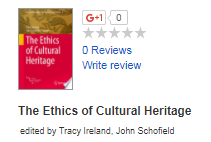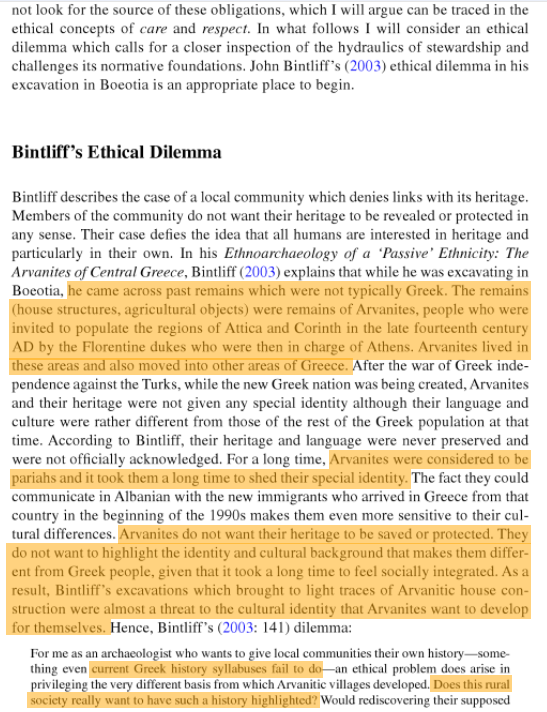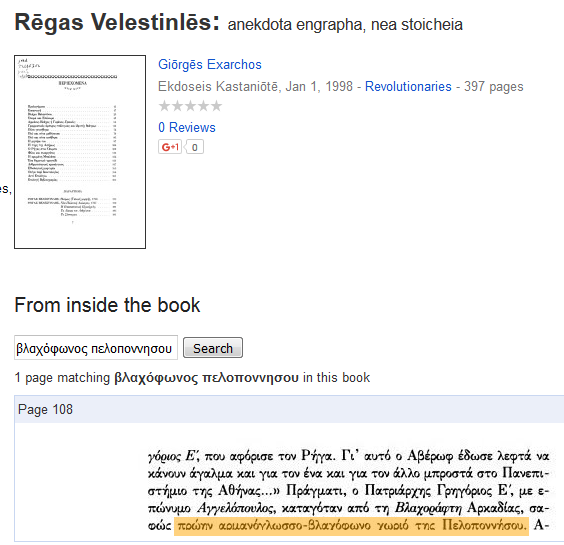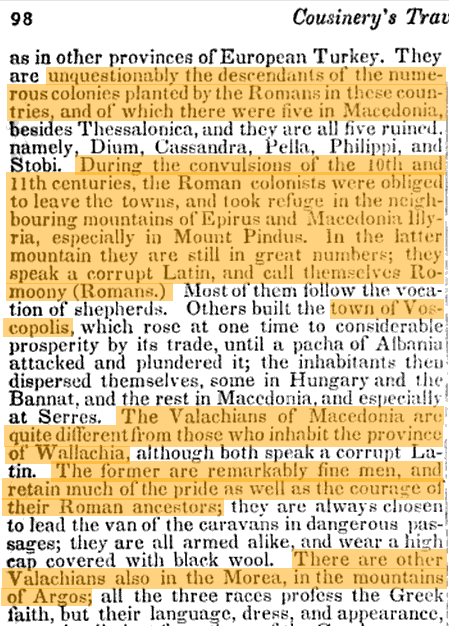Originally posted by Amphipolis
View Post
"Prior to 1865, Vlachs everywhere in the Peloponnese"
Collapse
X
-
These villages are real ones (Vlahokerasia for instance), they have websites, facebook pages, e-mails, dozens of you-tube videos and local cultural clubs. I recommend you contact them and ask them if they are, or ever were Vlachs, if they are anyhow related to Vlachs, if Vlach was until recently really spoken there, if they have ever heard who the Vlachs are etc.
Entire communities across Greece seem to deny links with its (lingustic and cultural) heritage. What would be the ultimate point of attempting to contact and offend people who want to be considered Hellenes? People have their reasons and rights to do so - and develop or have their own identity. It doesn't change certain historical facts or data though. I don't deny that people call themselves Hellenes or otherwise. Have you thought for a second to write to Mr. Peppas as well, and ask him the same question(s) you asked me? He is the one who wrote the book and regarding Vlahokerasia - which I simply shared on this forum. The following may be his blog -- http://ypeppas.blogspot.ca/2007/10/b...st_07.html?m=1 -- does this imply, that I am somehow responsible for his blogging / research? Namely,
1) Όπως και οι Αρβανίτες, έτσι και οι Βλάχοι ξεκίνησαν να κατεβαίνουν νότια ως βοσκοί και κτηνοτρόφοι στην αρχή. Στη συνέχεια, κύματα μεταναστών έφτασαν έως και την Πελοπόννησο, σε πολλά σημεία πριν να εμφανιστούν οι Αρβανίτες. --> Like the Arvanites, the Vlachs began to descend to the south as shepherds ..... waves of migrants reached the Peloponnesus, many times before the Arvanites appeared.
2) Τα ίδια χρόνια, οι Βλάχοι μετανάστες είχαν απλωθεί στις Μακεδονία, Θράκη, Ήπειρο, Θεσσαλία, Πελοπόννησο και ζούσαν σε πατριές (στρούγκες). --> During the same years, the Vlach immigrants had spread to Macedonia, Thrace, Epirus, Thessaly, Peloponnesus.
More importantly, if you think the study case Bintliff discovered (below) is somehow unique, it is not. This phenomenon is widespread. Many communities willingly or under pressure abandoned the use of their language or dialect.


 Last edited by Carlin; 06-16-2017, 05:12 AM.
Last edited by Carlin; 06-16-2017, 05:12 AM.
Comment
-
-
Carlin, these two Ioannis Peppas are two different persons. Their whole profile seems different and middle name (Evangelos, Pericles) is different. (By the way, there's a third one, an author of History books, yet he's also a different person, with an L as a middle name).Originally posted by Carlin View PostEntire communities across Greece seem to deny links with its (lingustic and cultural) heritage. What would be the ultimate point of attempting to contact and offend people who want to be considered Hellenes? People have their reasons and rights to do so - and develop or have their own identity. It doesn't change certain historical facts or data though. I don't deny that people call themselves Hellenes or otherwise. Have you thought for a second to write to Mr. Peppas as well, and ask him the same question(s) you asked me? He is the one who wrote the book and regarding Vlahokerasia - which I simply shared on this forum. The following may be his blog -- http://ypeppas.blogspot.ca/2007/10/b...st_07.html?m=1 -- does this imply, that I am somehow responsible for his blogging / research? Namely,
More importantly, if you think the study case Bintliff discovered (below) is somehow unique, it is not. This phenomenon is widespread. Many communities willingly or under pressure abandoned the use of their language or dialect.
I couldn't find anything about Ioannes Evangelos Peppas. This is his only book and I don't know what kind of book it is.
This isn't a philosophical aspect, but a matter of simple truth with a YES or NO answer. If Vlahokerasia is/was a Vlach village (not in 16th Century, but until recently, e.g. in the 1800s or in the 1970s) it would be very easy to find out, because... (gasp) it was/is full of people.
===Last edited by Amphipolis; 06-17-2017, 12:39 AM.
Comment
-
-
What is the explanation for the following toponyms, in a very specific area of Arcadia?
One village (one of hundreds, if not thousands in the Peloponnese), which is located in the heart of Arcadia is called Vitina, Vytina (Βυτίνα in Greek).
URL:
What is interesting, but not surprising at all, is that the SAME toponym can be found in Kosovo as well as in Herzegovina (actually, there is also Vitinica in Bosnia, and Vitinya Pass - which is a is a mountain pass in the Balkan Mountains in Bulgaria). What is more interesting is the connection between Vitina in Herzegovina and the Vlachs:
U nedatiranom i nepotpunom vlaškom defteru, nastalom poslije 1497., a prije 1500.godine, upisano je selo Vitina i to u dva dijela po 17 odraslih Vlaha, ukupno 34, od toga 22 oženjena i 12 neoženjenih. Uz selo Vitinu navodi se i mezra Vitina koju su obrađivali Vlasi. To znači da selo Vitina nije bila potpuno naseljena i da u njoj nisu obitavali ratari.
The undated and incomplete Vlach defter, completed after 1497 and before the year 1500, village Vitina is registered ... inhabited by Vlachs (numbers are provided for number of married and unmarried men, etc.). Along with village Vitina there is a mezra Vitina, cultivated by Vlachs. This means village Vitina was not fully occupied and that farmers did not live in it.
URL:
In addition to Vitina in Arcadia, some of the nearby settlements/villages have (or, used to have) the following names/toponyms:
Kamenitsa (i.e. this Slavic toponym can be found across numerous countries and regions - https://en.wikipedia.org/wiki/Kamenica)
Lasta
Nymfasia - until 1927., Γρανίτσα - Granitsa
Methydrio - until 1927., Νεμνίτσα - Nemnitsa
Since these settlements clearly and evidently bear non-Greek names, they were not founded by Greek-speakers. Moreover, it seems evident that at some point during historical times the inhabitants of all these villages spoke a non-Greek language/dialect (some people, i.e. social elite, or people associated with the church might have been bilingual and spoke Greek as well). If these villages were established by ethnic Greeks and/or Greek-speakers there should be some solid and bulletproof evidence - otherwise, any arguments based on zero data can only be understood as wishful thinking.
The basic questions are then - when did the total linguistic hellenization occur of the villages Vitina (Vytina), Kamenitsa, Lasta, Granitsa, Nemnitsa, and its inhabitants? When and how did the residents fully abandon its native dialect(s)? Why do the inhabitants don't remember this?
If the argument is that these villages were founded by ethnic Greeks, why would they name their own villages and settlements with non-Greek toponymy?
PS:
The father of the historian Constantine Paparrigopoulos, Dimitrios Paparrigopoulos was born in Vytina.
PPS:
Βλάχοι και Αρβανίτες στο Μοριά.
ΠΥΡΓΑΚΙ or ΠΥΡΓΟΣ ΤΡΙΦΥΛΛΙΑΣ --> The first who dwelt here were shepherds from the villages of Pyrgaki and Nemnitsa of Vytina.Last edited by Carlin; 06-18-2017, 12:06 PM.
Comment
-
-
The following is regarding Gortynian village Vlachorafti (Βλαχορράφτης, ή Βλαχορράφτι, ή και Βλαχόρραφτη, ή Μάραθα). As per point 1 below, the first settler was a Vlach shepherd. Per point 2 (screen grab), this village used to be Vlach-speaking.
URL:
1. Το σημερινό χωριό πήρε το όνομά του από κάποιον ποιμένα που έραβε βλάχικα ρούχα, ο οποίος ήταν και ο πρώτος οικιστής της περιοχής. --> The present village was named after a shepherd who wore Vlach clothing, who was also the first settler in the area.
2.

Comment
-
-
-
1) Whence the Name “Tsintzina” (also known as "Tsitsina")
The following are 'highlights' from the above "article" - copy & paste:
The core of Koukoules’ remarks about the name of Tsintzina is that:
· Tsintzina constitutes definitely a foreign word, possibly Slavic, more likely Albanian.[2]
· The name is the inheritance of Albanian settlers in the vicinity (in itself a controversial remark beyond reasonable proof)
Irrespective of substance, one has to admit that Koukoules’ thesis exerted considerable influence. Perhaps a direct result of his strongly assertive remarks, was that soon afterwards Tsintzina was forcibly renamed “Polidrosson” in one of a series of Governmental Decrees replacing over time all local names presumed as non-Greek.[3]. An astonishing paradox of Koukoules’ thesis however, is that he failed to recognize in the name “Goritsa” a much more clear foreign element than in either “Tsintzina” or the other nearby villages that were renamed.[4] As a result of this inexplicable oversight, the village of Goritsa was spared this fortune, though since, the notion of Tsintzina being a “foreign” name has anchored firmly even among Tsintzinians themselves.
Not only the village of Tsintzina but several others in of Mt. Parnon seem to have common names with villages in a particular cluster of Epirus: Some examples: Doliana, Meligou, Stolos, Sitena and Tsintzina correlate evidently with the Epirus villages of Doliana, Meligou, Stolovon, Satena and Zizina.
The Epirus connection highlighted by Vagenas, would adroitly strengthen the original Koukoules verdict, ie that Tsintzina is an Albanian word. Actually, Professor Koukoules advocated that Tsintzina is a derivative of the Albanian “tzitze”, a word denoting “akanthodes friganon” or “thorny shrub”.
Shuffling through the exceptional, six-volume compilation of Stachi Editions, containing almost all known travellers’ accounts to Greece since the classical times, there is quite a bit of material concerning our neigboring region of Tsakonia. There, in a footnote about some words of the well-acknowledged Tsakonia dialect, the meticulous reader will discern amid the small print the word “tsintzina”. How is it translated to common Greek? Plainly, velanidia, a shrub in abundance in Tsintzina and very useful in the processing of skins and leather, perhaps the commonest trade in Tsintzina at least in the years to M.F. Leake’s visit.
2) In the map/link below, the village appears as TSITSINA.
3) Polydroso/Polidrosson is a mountainous village of Laconia. Polydroso was formerly called Tsintzina or Tsintsina, while in the past the Tsakonic dialect was spoken.
4) FYI - Did you know that there is a village with the same name in Bosnia and Herzegovina?
Zagonetke trebinjske toponimije (2): U imenu okamenjeni i kultovi paganskih predaka
 Savo Pujić: „Davno nekad mislio sam se otkud je Crnač, kad nije nimalo crnji nego ova druga sela. Onda sam se sjetio
Savo Pujić: „Davno nekad mislio sam se otkud je Crnač, kad nije nimalo crnji nego ova druga sela. Onda sam se sjetio
Relics of Lost Ethnic Groups
The second group of toponyms, like Zupci, Bobani, Ugarci, Žurovići, Cicina, Sparožići - philologists and historians connect with the names of Vlach families and tribes, and the third group - with the words of Roman origin of general significance, where Turmani or Nevada hamlet have already been mentioned.
"When the Slavs moved here, they found the nomadic Vlach population, who spoke some of their Latin-Roman dialects. The Slavs, who were agricultural people (farmers), pushed the Vlachs to the upper parts, into the mountains, but still lived in harmony with each other and exchanged their goods and products," Pujić says.
5) Etymology - cincinnus (plural cincinni)
(botany), a type of monochasium on which the successive axes arise alternately in respect to the preceding one; a scorpioid cyme.
6) NOTES ON THE HISTORY OF TSINTZINA
Early village times remain unknown. Questions without a clear answer include:
About when did first Tsintzina settlers appeared in the area
Their profession.
The exact location of first houses
Likely other settlements around.
In pre-historic periods, human presence in upper Mt. Parnon seems unlikely. No remnants or tools were ever discovered. No evidence either that until the end of the stone age, this part of Mt. Parnon drew any significant populations. By contrast, its lower, western slopes did.
Byzantine & Early Ottoman Period.
Evidence suggests a continuous habitation of the surrounding area from the 9th century A.D.
St. Anargiroi Monastery (some 3 miles to the southwest) seems initially built at that time.
The earliest known reference to Tsintzina –at least as location- appears in a Byzantine Imperial Decree of 1292 or 1295 AD 6,7. In another Imperial Decree of 1416, the penultimate Emperor Theodore II Paleologos, specifies details about taxation levied on the people of Tsintzina and other nearby villages.
First Tsintzina settlers most probably resided in the Baouti area, on the village southwest. St. Vlassios seems the first village church, dating back to –at least- the 16th century.
In the first few years after Independence from the Ottoman Turks in 1929, Tsintzinians consolidated their earlier settlements of Zoupena and Goritsa, some 20 miles to the South.
The emergence of the sister villages of Goritsa & Zoupena, is attributed to mass migration of Tsintzinians in the Lakonia plains, commencing near the end of the 18th Century.Last edited by Carlin; 06-25-2017, 03:24 PM.
Comment
-
-
Χρονικά των Τσακώνων - Πρακτικά Ζ' Τσακώνικου Συνεδρίου, Τόμος ΚΒ' 1/3
 Εδώ μπορείτε να διαβάσετε τον τόμο Τόμος ΚΒ' 1/3 που περιέχει τα πρακτικά του Ζ΄ Τσακώνικου Συνεδρίου το οποίο πραγματοποιήθηκε το 2013 στην Λαϊκή Βιβλιοθήκη Λεωνιδίου. Στο Συνέδριο δήλωσαν συμμετοχή 43 πανεπιστημιακοί καθηγητές, ιστορικοί, εκδότες, συγγραφείς, ποιητές, λαογράφοι, μουσικολόγοι, νομικοί, μηχανικοί και άλλες προσωπικότητες των γραμμάτων και των τεχνών οι οποιοι παρουσίασαν ανακοινώσεις με θέματα που αναφέρονται στην Ιστορία, Αρχαιολογία, Γλωσσολογία, Λαογραφία, Αρχιτεκτονική και Διασπορά των κατοίκων της ευρύτερης περιοχής Τσακωνιάς.
Εδώ μπορείτε να διαβάσετε τον τόμο Τόμος ΚΒ' 1/3 που περιέχει τα πρακτικά του Ζ΄ Τσακώνικου Συνεδρίου το οποίο πραγματοποιήθηκε το 2013 στην Λαϊκή Βιβλιοθήκη Λεωνιδίου. Στο Συνέδριο δήλωσαν συμμετοχή 43 πανεπιστημιακοί καθηγητές, ιστορικοί, εκδότες, συγγραφείς, ποιητές, λαογράφοι, μουσικολόγοι, νομικοί, μηχανικοί και άλλες προσωπικότητες των γραμμάτων και των τεχνών οι οποιοι παρουσίασαν ανακοινώσεις με θέματα που αναφέρονται στην Ιστορία, Αρχαιολογία, Γλωσσολογία, Λαογραφία, Αρχιτεκτονική και Διασπορά των κατοίκων της ευρύτερης περιοχής Τσακωνιάς.
On page 43 (link above) starts an article which states that Tsakonians are descendants of the THRACIAN tribe of CAUCONES.
Comment
-
-
On what historical event do they rely on?Originally posted by Carlin View PostΧρονικά των Τσακώνων - Πρακτικά Ζ' Τσακώνικου Συνεδρίου, Τόμος ΚΒ' 1/3
 Εδώ μπορείτε να διαβάσετε τον τόμο Τόμος ΚΒ' 1/3 που περιέχει τα πρακτικά του Ζ΄ Τσακώνικου Συνεδρίου το οποίο πραγματοποιήθηκε το 2013 στην Λαϊκή Βιβλιοθήκη Λεωνιδίου. Στο Συνέδριο δήλωσαν συμμετοχή 43 πανεπιστημιακοί καθηγητές, ιστορικοί, εκδότες, συγγραφείς, ποιητές, λαογράφοι, μουσικολόγοι, νομικοί, μηχανικοί και άλλες προσωπικότητες των γραμμάτων και των τεχνών οι οποιοι παρουσίασαν ανακοινώσεις με θέματα που αναφέρονται στην Ιστορία, Αρχαιολογία, Γλωσσολογία, Λαογραφία, Αρχιτεκτονική και Διασπορά των κατοίκων της ευρύτερης περιοχής Τσακωνιάς.
Εδώ μπορείτε να διαβάσετε τον τόμο Τόμος ΚΒ' 1/3 που περιέχει τα πρακτικά του Ζ΄ Τσακώνικου Συνεδρίου το οποίο πραγματοποιήθηκε το 2013 στην Λαϊκή Βιβλιοθήκη Λεωνιδίου. Στο Συνέδριο δήλωσαν συμμετοχή 43 πανεπιστημιακοί καθηγητές, ιστορικοί, εκδότες, συγγραφείς, ποιητές, λαογράφοι, μουσικολόγοι, νομικοί, μηχανικοί και άλλες προσωπικότητες των γραμμάτων και των τεχνών οι οποιοι παρουσίασαν ανακοινώσεις με θέματα που αναφέρονται στην Ιστορία, Αρχαιολογία, Γλωσσολογία, Λαογραφία, Αρχιτεκτονική και Διασπορά των κατοίκων της ευρύτερης περιοχής Τσακωνιάς.
On page 43 (link above) starts an article which states that Tsakonians are descendants of the THRACIAN tribe of CAUCONES.
Comment
-
-
They rely on no actual historical events or data that connect today's Tzakonians with the ancient CAUCONES. It's just mental gymnastics and connecting the term 'CAUCONES' to 'Tzakonians'.Originally posted by tchaiku View PostOn what historical event do they rely on?
I posted it as I found it rather curious: What is interesting is the following - why did this Modern Greek author even bother to search for Thracian-Cauconian roots of Tzakonians if they are pure Dorians, that is Hellenes? Isn't this question long settled at least among the Tzakonians and Greeks themselves? Isn't the Dorian-Spartan story good enough? Perhaps, deep down - do they somehow know and feel that they are not Hellenes?Last edited by Carlin; 06-28-2017, 09:16 PM.
Comment
-
-
Where did you find this?Originally posted by Carlin View Post
3) Jakob Philipp Fallmerayer (1790-1861).
Focusing on the Albanians, this is how Fallmerayer described the Morea in the 19th century:
i) If the many colonies of Albanian immigrants had already exchanged their native tongue for modern Greek, as their predecessors, the Slavs, had done, and as could have happened over the centuries, the opponents of my theory of Albanian migration covering all of new Greece would have had an easier time of it refusing to believe me, because the new arrivals, comrades in religion and governance of the Greek-speakers, did not have the same destructive influence on place names, as did the Slavs. Phrantzes asserts: “Half of Peloponnese land was actually occupied by the Albanians at that time and they attempted to get the other half, too, both by force of arms and by negotiation with Sultan Mehmed II.” In the works of Chalkokondylas, Spandugino and Phrantzes, or similarly concerning the Slavic occupation of the Peloponnese in Evagrius, Constantine Porphyrogenetus, the Scholiast of Strabo and Patriarch Nicholas, the above-mentioned scholars would only come up with the same old explanations, i.e. that “these are merely assertions of a general nature that must be treated with caution when applied; they are assertions that reflect more a lack of knowledge or imprecision on the part of the writer than truth and exactitude.” Unfortunately for the friends of ancient Greek cause, gentle folk they may be, though not particularly astute, the inhabitants of the Academy of Plato and of all of Attica, of Boeotia, Megara, Corinth, Argolis, Hydra, Spetzia, Phlius and the interior of the Morea, have preserved the customs, language and clothing of their native land to the present day. However, if we take a look solely at the Peloponnese, no one would accept that the martial advance of the Albanians through the peninsula at the time of Cantacuzene simply came to a stop and consisted merely of a few small units of men or a few mercenaries who left their families at home. Once curious piece of information is preserved in the funeral oration of Theodor Palaeologus, the successor of Cantacuzene in Mistra (1380-1407), that shows just how continuously and massively the Albanians flooded across the isthmus: “Ten thousand Illyrians, i.e. Albanians, were given residence in the Peloponnese by Theodor Palaeologus, and these ten thousand men brought their women and children, their possessions and animals with them.”
If one considers that all the families of Albanians who arrived in the Morea during the rule of Manuel Cantacuzene and Theodor Palaeologus, in the province of Mistra. i.e. in the Eurotas valley, had to be accommodated in southeastern Arcadia, Tsakonia and the towards Argolis, it is easy to see that the districts inhabited by Slavs and, on the east side, apparently by some remnants of the ancient Greeks, were largely empty. And if one considers that before and during these events there was a time when there were less than 150,000 people in the whole of the Peloponnese, one can easily comprehend how limited the knowledge of the philosopher Plethon in the fifteenth century was, who refused to accept any substantial alteration in the population of the Peloponnese. The same is can be said of his successors in the present day, at least in this part of the world.
ii) Nerio had empty villages, fallow fields, many enemies and no soldiers. The Albanians were on the lookout for land, war and booty.
iii) Several years later, the adventuresome Castellan of Corinth gained control over most of the lands of the Parea that were plunged into war and subject to Sicilian influence, and spread Albanian colonies to Attica and Boeotia where this people still resides pure and unmixed with others. With the exception of some villages in Boeotia and the cities of Thebes and Athens where the population during the last uprising was a mixture of people from all regions, Albanian blood is dominant and is most prevalent in the lower classes. At the present time, Athens, the capital of the new kingdom, is more Albanian than it was during the uprising because, after the expulsion of the much-hated and feared Ottomans, the Albanian population abandoned the countryside in great numbers and settled in the city.Last edited by tchaiku; 07-27-2017, 02:13 PM.
Comment
-
-
Why didnt they test Albanians and South Slavs? Fallmerayer believed two-thirds of Morea was inhabited by Albanians.
BTW the dna of Tsakonians shares very little proto Slavic dna less than other Greeks and is more different than the rest of other regions. It is interesting.
Comment
-









Comment